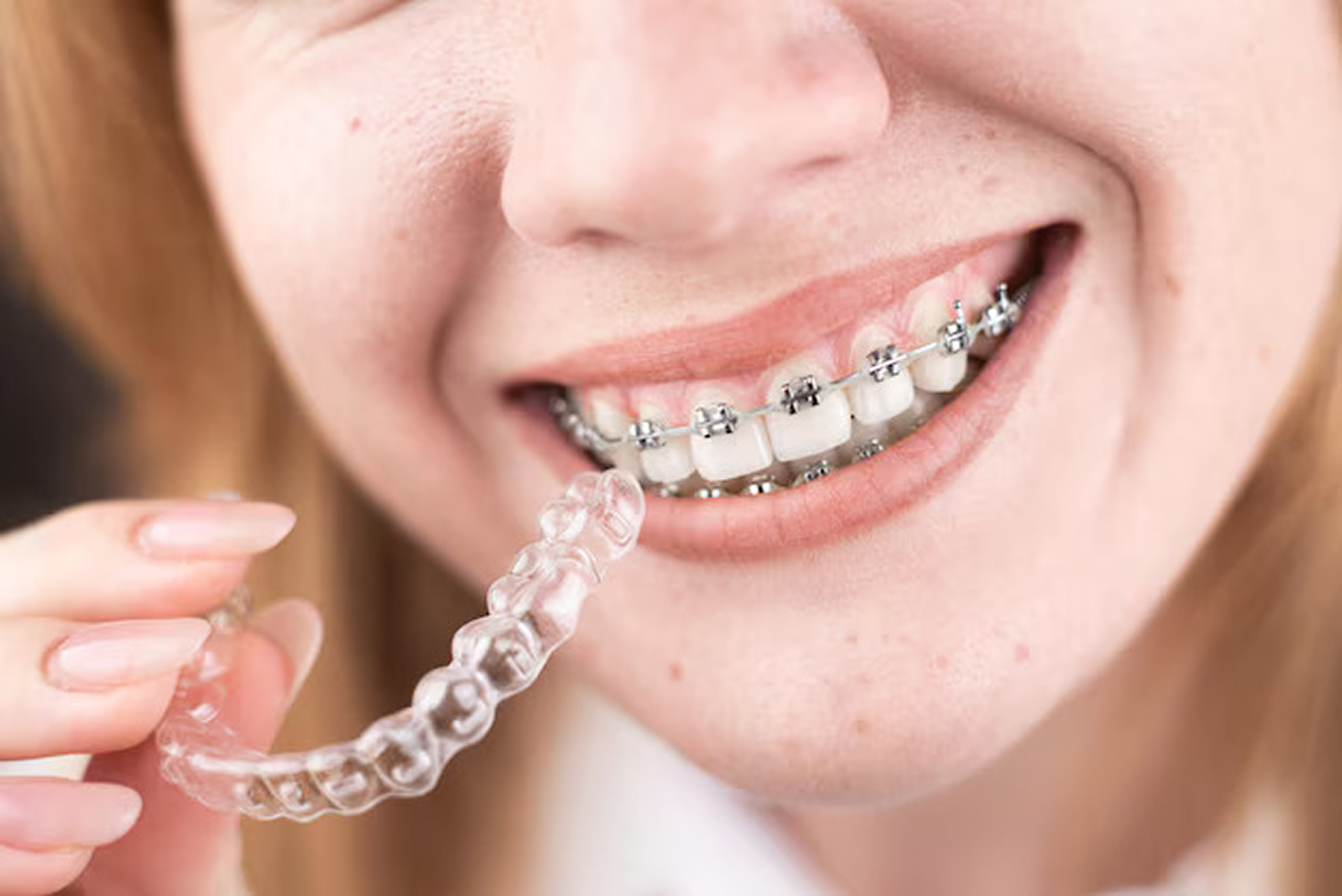Some adults considering orthodontic treatment may be interested in options that are less noticeable and fit seamlessly into their daily routines. Among these, Invisalign aligners are sometimes considered for their clear appearance and removable design. These features may appeal to those seeking an alternative to metal braces.
In 2025, advancements in clear aligner materials and digital imaging have enhanced treatment planning. These developments have contributed to the effective use of aligners in appropriate adult cases. Whether someone proceeds depends on their individual needs, treatment goals, and daily habits. Naturally, the situation leads some people to ask: Is it worth getting Invisalign as an adult?
This article outlines key considerations—benefits, limitations, and practical factors—to support a well-informed decision about this treatment option.
Summary of the Content:
- Invisalign aligners are a discreet orthodontic option that uses custom-made, BPA-free plastic trays to guide teeth into alignment.
- Treatment begins with a digital scan and personalised plan, followed by wearing a series of aligners in a specific sequence.
- Aligners are typically worn for 20 to 22 hours a day and changed every one to two weeks, depending on progress.
- Invisalign may be suitable for mild to moderate issues, such as spacing, crowding, or specific bite concerns.
- Treatment success depends on consistent wear, oral hygiene, and the complexity of each case.
- Alternatives such as metal, ceramic, or lingual braces may be more appropriate for complex orthodontic needs.
- The cost of treatment varies depending on treatment duration, case complexity, and the number of aligners required.
- A personalised assessment is the only way to determine whether Invisalign is appropriate for your circumstances.
What Is Invisalign and How Does It Work?
Invisalign is a type of clear aligner treatment that applies gentle pressure to improve the alignment of teeth over time. Instead of using metal brackets and wires, this approach involves wearing a series of aligners made from flexible, medical-grade, BPA-free plastic.
Each set of Invisalign aligners is created using a digital scan of your teeth. This scan enables the development of a personalised treatment plan, which outlines the expected tooth movements in small, controlled steps. The aligners are worn in a specific order, and each one is slightly different, designed to direct movement during each stage of the treatment process gradually.
Aligners are typically changed every one to two weeks, depending on your progress and the number of aligners needed. They are designed to be worn for 20 to 22 hours per day and only removed for eating, brushing, and flossing. This level of patient compliance can significantly impact the effectiveness of the Invisalign process.
The aligners apply gentle, consistent pressure to the teeth, encouraging movement in line with the planned adjustments. Over time, this may help address mild to moderate orthodontic issues, including spacing issues, mild crowding, and certain types of bite problems.
Why Adults Consider Invisalign Clear Aligners in 2025
Adults considering orthodontic treatment may seek options that suit both their lifestyle and appearance. In 2025, several features of Invisalign clear aligners may appeal to those considering alternatives to traditional braces. Individual outcomes may vary, but common reasons for selecting this treatment option include the following:
- Discreet appearance:
Invisalign aligners are made from a transparent, BPA-free plastic that fits closely over the teeth. Due to their nearly invisible design, people are less likely to notice them during everyday interactions. This option may be especially appealing to adults attending social or professional events where they prefer to avoid drawing attention to their orthodontic treatment. - Removable design:
Unlike traditional metal braces, Invisalign aligners are removable. This allows patients to take them out during meals or while brushing and flossing. For those who want to maintain good oral hygiene with minimal interruption to daily routines, this feature can offer greater flexibility. - Fewer dietary restrictions:
Because there are no metal brackets or wires, there are generally fewer food restrictions compared to conventional braces. Adults can continue to enjoy a wide variety of foods, provided that aligners are removed beforehand and teeth are cleaned before reinsertion. - Digital planning and visual previews:
The Invisalign procedure often begins with a digital scan, which is used to create a personalised treatment plan. Some clinics offer digital previews that may help patients understand how their teeth alignment could change over time. This level of visual planning can support informed decision-making. - Gradual movement and custom fit:
Each set of aligners is custom-made to follow the sequence of the treatment plan, applying gentle pressure to support tooth movement. For mild to moderate orthodontic issues, invisible aligners may provide a more comfortable experience than traditional brackets and wires, although individual factors will determine the outcome. - Lifestyle considerations for adults:
Busy adults may prefer a treatment that requires fewer visits and allows more control over daily wear. The ability to remove the aligners during important moments, such as presentations, family events, or meals, may influence the decision for some individuals.
Is Invisalign Worth It for Every Adult?
Every adult has different needs and goals when it comes to orthodontic treatment, which is why a personalised approach is essential. For those weighing up their options, a common question is: Is it worth getting Invisalign as an adult? While Invisalign clear aligners may be suitable for some individuals, several key factors should be considered before determining if this treatment option is the right fit for you. Key suitability factors to consider include the following:
- Oral health:
Healthy teeth and gums are essential before starting any type of orthodontic treatment. Active gum disease or tooth decay may need to be managed first, as these conditions can impact the fit of aligners and treatment progress. - Case complexity:
Invisalign aligners are often used for mild to moderate orthodontic issues. These issues may include spacing concerns, mild crowding, or minor bite irregularities. Adults with more complex problems, such as significant jaw pain or severe misalignment, may require an alternative to clear aligners. - Commitment to wear time:
Wearing the aligners for 20–22 hours per day plays a crucial role in the treatment’s progress. Inconsistent wear or frequent removal may slow down tooth movement and extend the overall treatment duration. Adults should assess whether they can maintain the daily routine required for optimal progress.
Pros of Invisalign for Adults
Adults often seek teeth straightening options that blend discreetly into their professional and personal lives. While results vary, these are some potential benefits of choosing Invisalign for adults:
- Discreet appearance:
The aligners are made from a transparent plastic material, designed to be less noticeable during everyday interactions due to their transparent material. - Removable aligners:
Aligners can be removed for meals, brushing, flossing, or important social occasions, offering more flexibility for adults who prefer a removable option. - Ease of cleaning:
Without brackets and wires, brushing and flossing are often easier. This may support maintaining oral hygiene throughout treatment. - Fewer dietary restrictions:
Since aligners are removed during meals, adults can enjoy a variety of foods without the concerns associated with sticky or hard textures. - Comfortable fit:
Custom aligners are designed to apply gentle pressure without the irritation that metal wires or brackets can sometimes cause. - Fewer visits:
In many cases, treatment involves fewer visits, which can benefit busy adults balancing appointments with other responsibilities.
Challenges or Limitations to Consider
While Invisalign aligners may offer certain advantages, they also come with responsibilities and limitations. The following points may help adults decide if this treatment option aligns with their lifestyle and goals:
- Discipline is required:
Aligners must be worn for 20–22 hours per day to support the intended progress of the treatment. Skipping wear time or inconsistent use can affect results and extend the treatment process. - Cost of Invisalign treatment:
The cost of Invisalign can be a significant factor. Invisalign treatment costs may vary depending on the treatment duration, number of aligners needed, and whether additional procedures are involved. Payment plans may be available, but overall expenses vary depending on individual needs. - Not suitable for all cases:
More complex cases involving severe misalignment or significant bite issues may require conventional metal braces or alternative treatments. - Responsibility for care:
Because aligners are removable, individuals are responsible for keeping them clean and storing them safely to prevent loss or damage. Aligners should be cleaned with mild soap and rinsed with lukewarm water to avoid warping.
Invisalign Treatment Cost for Adults
The cost of Invisalign treatment can vary depending on several personal and clinical factors. Since every smile is different, pricing is determined by the specifics of your individual needs and the details of your treatment plan. Here are a few key elements that may influence the overall cost:
- Treatment duration:
The total time required to complete your Invisalign journey influences the number of aligner sets used and the number of appointments needed. Longer treatment plans may result in a higher overall cost. - Number of aligners:
A customised sequence of aligners is designed to guide your teeth through progressive stages of movement. A greater number of aligners typically reflects more complex tooth movements and may result in a higher cost. - Additional services:
Some individuals may require retainers, bite adjustments, or diagnostic scans, which can contribute to the treatment cost. Usually, the consultation and planning phase includes these elements. - Case complexity:
The type and severity of your orthodontic issues can impact the number of aligners required and whether additional procedures are necessary. Addressing mild crowding or minor spacing issues may involve fewer aligners than managing moderate orthodontic problems.
What to Expect from the Invisalign Treatment Process
The Invisalign process involves several stages that are tailored to your specific orthodontic needs. While the treatment generally follows a step-by-step approach, the exact details may differ for each person. The treatment duration, number of aligners, and overall experience will vary depending on your specific case. Here is an overview of what you may expect:
- Initial consultation:
The process usually begins with an initial consultation. This visit typically includes an evaluation of your teeth and gums. Your dental provider will also discuss your treatment goals and assess whether Invisalign aligners may be suitable for your orthodontic needs. - Digital scans or impressions:
If Invisalign is considered appropriate, a digital scan or impression of your teeth will be taken. This scan is used to develop a personalised treatment plan that helps determine the anticipated number of aligners needed and the stages of tooth movement. - Custom aligner creation:
Based on the scan, a series of custom aligners is created to guide your teeth into their desired position gradually. Each aligner is slightly different, reflecting the changes mapped out in the treatment plan. The aligners are usually made from a BPA-free plastic and designed to fit snugly over your teeth. - Wearing the aligners:
Most adults are advised to wear each set of aligners for approximately one to two weeks. Aligners are worn for 20 to 22 hours per day and are removed only for eating, drinking (except water), brushing, and flossing. Wearing the aligners as directed plays a significant role in supporting treatment progress. - Regular checkups:
Follow-up visits are scheduled periodically to monitor your progress. These appointments may be less frequent than those required for conventional braces, but they remain an essential part of the process. Your dentist will assess how your teeth are progressing and may adjust your plan if necessary. - Final stage and retainers:
After the final set of Invisalign aligners has been worn, you may be advised to wear retainers to help maintain the new position of your teeth. The retention phase is a standard component of orthodontic treatment, helping to support long-term stability.
Alternative Teeth Straightening Options You Might Explore
While Invisalign aligners may be suitable for some adults, they are not the only option available. The most appropriate choice depends on your orthodontic needs, treatment goals, and the professional advice provided during your consultation. Here are a few other teeth straightening options that may be recommended depending on your individual needs and clinical assessment:
- Traditional metal braces:
This option uses metal brackets and wires to move teeth into alignment gradually. They remain a common choice for addressing more complex cases, including significant bite issues or severe tooth misalignment. - Ceramic braces:
Ceramic braces work in a similar way to metal braces, but they use tooth-coloured or clear brackets for a less noticeable appearance. They may appeal to adults who want a secure option that is slightly more discreet. - Lingual braces:
These braces are placed behind the teeth, making them hidden from view during speech or smiling. Not all adults are candidates for this option, and they may require more maintenance or adjustment time.
Final Thoughts
Invisalign aligners may offer a flexible and discreet way for adults to explore orthodontic treatment, particularly for mild to moderate concerns. That said, is it worth getting Invisalign as an adult? The answer depends on your specific needs, oral health, and how consistently you can wear the aligners as directed.
While many adults appreciate the convenience of removable aligners and the ease of maintaining oral hygiene, other options may be more appropriate depending on individual needs and lifestyle factors.
If you are considering Invisalign, a personalised assessment at Willeri Dental Parkwood can help determine whether this approach aligns with your goals and treatment needs.








